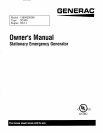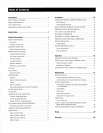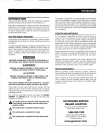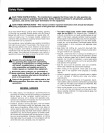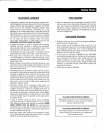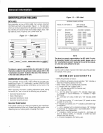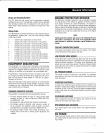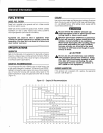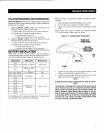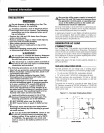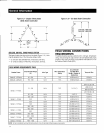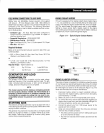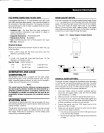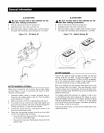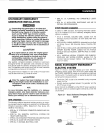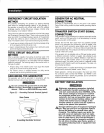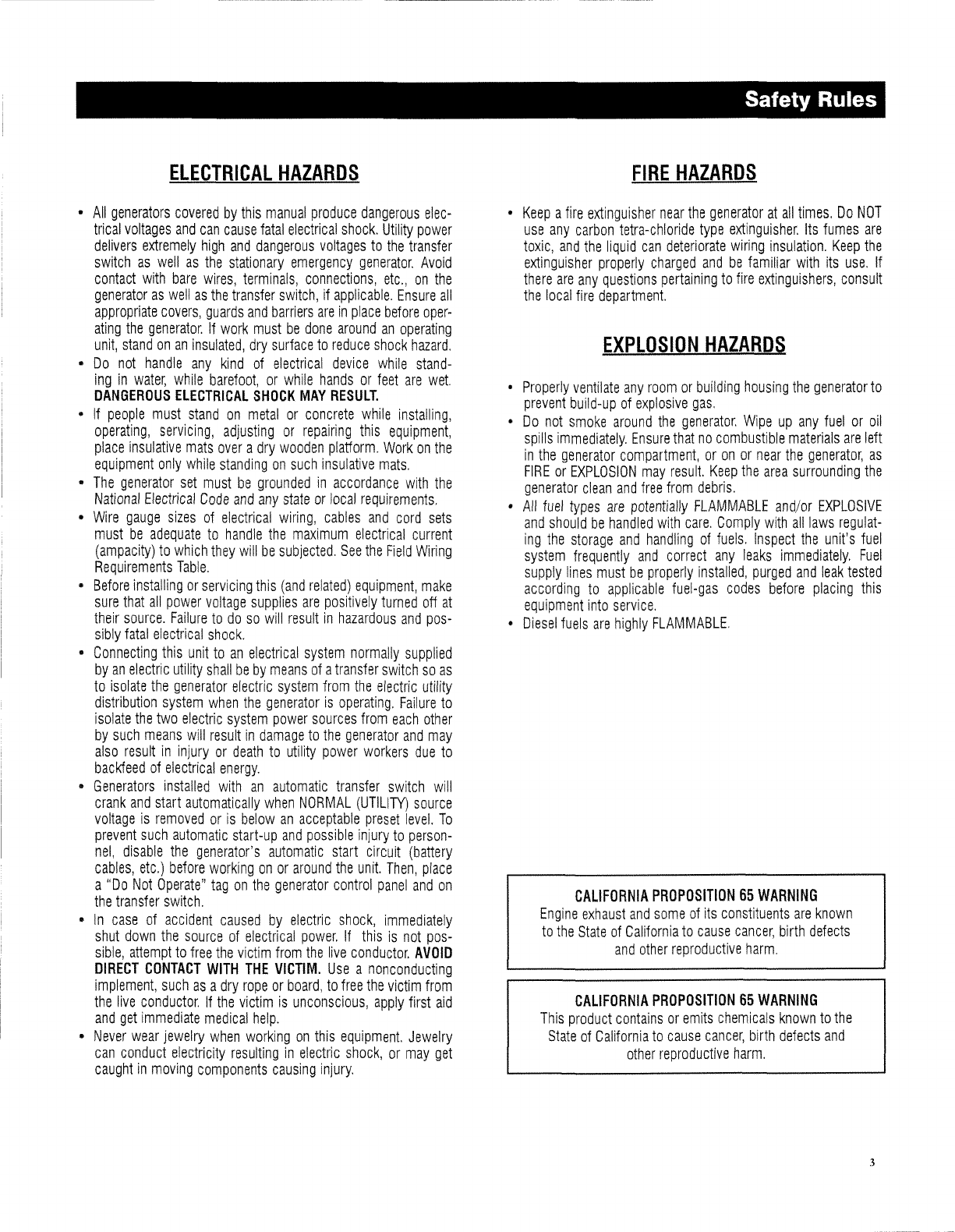
ELECTRICAL
HAZARDS
•
All
generators
covered
by
this
manual
produce
dangerous
elec-
trical
voltages
and
can
cause
fatal
electrical
shock.
Utility
power
delivers
extremely
high
and
dangerous
voltages
to
the
transfer
switch
as
well
as
the
stationary
emergency
generator.
Avoid
contact
with
bare
Wires,
terminals,
connections,
etc.,
on
the
generator
as
well
as
the
transfer
switch,
if
applicable.
Ensure
all
appropriate
covers,
guards
and
barriers
are
in
place
before
oper-
ating
the
generator.
If
work
must
be
done
around
an
operating
unit,
stand
on
an
insulated,
dry
surface
to
reduce
shock
hazard.
•
Do
not
handle
any
kind
of
electrical
device
while
stand-
ing
in
water,
while
barefoot,
or
while
hands
or
feet
are
wet.
DANGEROUS
ELECTRICAL
SHOCK
MAY
RESULT.
•
If
people
must
stand
on
metal
or
concrete
while
installing,
operating,
servicing,
adjusting
or
repairing
this
equipment,
place
insulative
mats
over
a
dry
wooden
platform.
Work
on
the
equipment
only while
standing
on
such
insulative
mats.
•
The
generator
set
must
be
grounded
in
accordance
with
the
National
Electrical
Code
and
any
state
or
local
requirements.
•
Wire
gauge
sizes
of
electrical
wiring,
cables
and
cord
sets
must
be
adequate
to
handle
the
maximum
electrical
current
(ampacity)
to
which
they
will
be
subjected.
See
the
Field
Wiring
Requirements
Table.
•
Before
installing
or
servicing
this
(and
related)
equipment,
make
sure
that
all
power
voltage
supplies
are
positively
turned
off
at
their
source.
Failure
to
do
so
will
result
in
hazardous
and
pos-
sibly
fatal
electrical
shock.
•
Connecting
this
unit
to
an
electrical
system
normally
supplied
by
an
electric
utility
shall
be
by
means
of
a
transfer
switch
so
as
to
isolate
the
generator
electric
system
from
the
electric
utility
distribution
system
when
the
generator
is
operating.
Failure
to
isolate
the
two
electric
system
power
sources
from
each
other
by
such
means
will
result
in
damage
to
the
generator
and
may
also
result
in
injury
or
death
to
utility
power
workers
due
to
backfeed
of
electrical
energy.
•
Generators
installed
with
an
automatic
transfer
switch
will
crank
and
start
automatically
when
NORMAL
(UTILITY)
source
voltage
is
removed
or
is
below
an
acceptable
preset
level.
To
prevent
such
automatic
start-up
and
possible
injury
to
person-
nel,
disable
the
generator's
automatic
start
circuit
(battery
cables,
etc.)
before
working
on
or
around
the
unit.
Then,
place
a
"Do
Not
Operate"
tag
on
the
generator
control
panel
and
on
the
transfer
switch.
•
In
case
of
accident
caused
by
electric
shock,
immediately
shut
down
the
source
of
electrical
power.
If
this
is
not
pos-
sible,
attempt
to
free
the
victim
from
the
live
conductor.
AVOID
DIRECT
CONTACT
WITH
THE
VICTIM.
Use
a
nonconducting
implement,
such
as
a
dry
rope
or
board,
to
free
the
victim
from
the
live
conductor.
If
the
victim
is
unconscious,
apply
first
aid
and
get
immediate
medical
help.
•
Never
wear
jewelry
when
working
on
this
equipment.
Jewelry
can
conduct
electricity
resulting
in
electric
shock,
or
may
get
caught
in
moving
components
causing
injury.
Safety Rules
FIRE
HAZARDS
•
Keep
a
fire
extinguisher
near
the
generator
at
all
times,
Do
NOT
use
any
carbon
tetra-chloride
type
extingUisher,
Its
fumes
are
toxic,
and
the
liquid
can
deteriorate
wiring
insulation.
Keep
the
extinguisher
properly
charged
and
be
familiar
with
its
use.
If
there
are
any
questions
pertaining
to
fire
extinguishers,
consult
the
local
fire
department.
EXPLOSION
HAZARDS
•
Properly
ventilate
any
room
or
building
housing
the
generator
to
prevent
bUild-Up
of
explosive
gas,
•
Do
not
smoke
around
the
generator,
Wipe
up
any
fuel
or
oil
spills
immediately.
Ensure
that
no
combustible
materials
are
left
in
the
generator
compartment,
or
on
or
near
the
generator,
as
FIRE
or
EXPLOSION
may
result.
Keep
the
area
surrounding
the
generator
clean
and
free
from
debris.
•
All
fuel
types
are
potentially
FLAMMABLE
and/or
EXPLOSIVE
and
shOUld
be
handled
with
care,
Comply
with
all
laws
regulat-
ing
the
storage
and
handling
of
fuels,
Inspect
the
unit's
fuel
system
frequently
and
correct
any
leaks
immediately,
Fuel
supply
lines
must
be
properly
installed,
purged
and
leak
tested
according
to
applicable
fuel-gas
codes
before
placing
this
equipment
into
service,
•
Diesel
fuels
are
highly
FLAMMABLE.
CALIFORNIA
PROPOSITION
65
WARNING
Engine
exhaust
and
some
of
its
constituents
are
known
to
the
State
of
California
to
cause
cancer,
birth
defects
and
other
reproductive
harm.
CALIFORNIA
PROPOSITION
65
WARNING
This
product
contains
or
emits
chemicals
known
to
the
State
of
California
to
cause
cancer,
birth
defects
and
other
reproductive
harm
3



